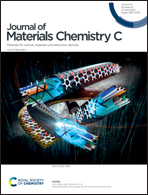van der Waals 2D metallic materials for low-resistivity interconnects†
Abstract
van der Waals 2D metallic materials offer a solution to the problem of poor scalability of elemental metals within ever-downscaling device interconnects due to their absence of surface scattering. Here we evaluate the viability of a selection of 2D metals, including transition metal dichalcogenides (TMDs), transition metal carbides/nitrides (MAX), and metal oxyhalides/oxyhydroxides (MOX/MOOH), for use as low resistivity interconnect materials in the extremely scaled geometries (critical dimension d < 10 nm). A widely adopted figure of merit, the product of resistivity and mean free path (ρλ), is used as the basis for a series of first-principles investigations. Our results show that many of these 2D metallic compounds exhibit comparable or even superior conductivities to elemental bulk Cu and Ru in the limit of sub-10 nm narrow wires. The search criterion for low resistivity 2D metals reveals that the conductivity is determined by the Fermi surface area, which characterizes the available electronic states that can contribute to the electrical conduction. Valence electron density and the Fermi surface shape are identified as the two primary factors governing the figure of merit ρλ. These findings could provide useful insights toward identifying a practical descriptor for further discovering highly conductive 2D metals. Given that 2D materials provide high metallic conductivity even at decreased scale, these candidates could potentially replace Ru for interconnects in future integrated circuits.



 Please wait while we load your content...
Please wait while we load your content...